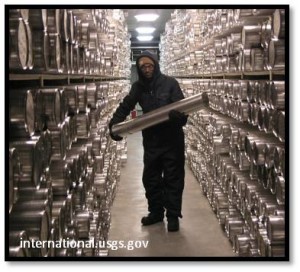 Ice cores, drilled from the polar ice caps of Antarctica and Greenland most commonly, but also from places as diverse as Africa, Bolivia, China, Peru, Russia and even the United States are the most accurate means to proving a window into the paleoclimate record in Earth’s history, including past climatic and environmental conditions. Drilling miles deep into glacial ice yields millennia of information on volcanic eruptions, storms, atmospheric carbon dioxide, and even meteorite activity.
Ice cores, drilled from the polar ice caps of Antarctica and Greenland most commonly, but also from places as diverse as Africa, Bolivia, China, Peru, Russia and even the United States are the most accurate means to proving a window into the paleoclimate record in Earth’s history, including past climatic and environmental conditions. Drilling miles deep into glacial ice yields millennia of information on volcanic eruptions, storms, atmospheric carbon dioxide, and even meteorite activity.
Ice cores can be used to reconstruct an uninterrupted and detailed climate record extending over hundreds of thousands of years, providing information on a wide variety of aspects of climate at each point. Each layer of snow is unique in chemistry and texture. Summer brings 24 hours of sunlight to the Polar Regions. The top layer of the snow changes in texture—not melting exactly, but changing enough to be different from the snow it covers. As the season again turns cold and dark, more snow falls, forming new layers. Each of these layers gives scientists a treasure trove of information about the climate for each section. Like marine sediment cores, an ice core provides a vertical timeline of past climates.
Shallow cores, or the upper parts of cores in high-accumulation areas, can be dated exactly by counting individual layers, each representing a year. These layers may either vary chemically or in their isotopic ratio. For example, snow from colder periods has less of the heavier isotopes. Deeper into the core, the layers thin out due to ice flow and high pressure. Eventually individual years cannot be distinguished.
Within air bubbles, snow and ice layers trap hydrogen and oxygen isotopes from our past. Sediment layers may contain sulfates from volcanoes and dust from violent desert storms. These layers can be used to reconstruct the history of volcanic activity and indicate the extent of desertification in prehistoric times. Oxygen isotopes within the ice are indicators of the temperature at the time the snow fell. Volcanic eruptions may be detected by visible ash layers or acidic chemistry.
Some composition changes are detected by high-resolution scans of electrical resistance. Lower down, the ages are reconstructed by modeling accumulation rate variations and ice flow.
Ice core studies reveal that today’s carbon dioxide, methane, and nitrous oxide levels are the highest in 800,000 years. In the Antarctic, the levels of chlorofluorocarbons (CFCs)—ozone depleting gases— have been measured in firn-ice (compacted snow that is not yet glacial ice). They were almost zero around 1880, but have grown in step with increasing industrialization and proliferating human population.
Ice Core Projects
In the US, the National Ice Core Laboratory – Science Management Office (NICL-SMO), which is funded by the National Science Foundation Office of Polar Programs, provides scientific management of the National Ice Core Laboratory (NICL). The NICL houses 17,000 meters of ice cores recovered from Greenland and Antarctica that are available for study.
The availability of ice core data from several locations around the world is crucial to the reconstruction of a detailed climate map globally but the current downward trend in the economy is also affecting the availability of this precious data.
The Geological Survey of Canada research lab which has an ice core archive comprising of ice from high Arctic glaciers, Mount Logan, Ellesmere, Baffin and Devon islands, is scheduled for shutdown. The fate of the collection, containing over 40 years of data is being disputed. The GSC plans to focus on other research projects, such as the melting of permafrost and the effects of pipeline construction while winding down its ice core research program.
The maintenance of ice core projects across the world should be a concern for everyone as data from ice core collections not only show the link between historical climate research and current concerns about human influenced global warming. Ice core research has the ability to influence environmental policy in governments globally. It is crucial in providing evidence of human influence on climate and atmospheric change.
Those interested in ice core studies will want to attend the Open Science Conference of the International Partnerships in Ice Core Sciences (IPICS), October 1-5, 2012 at the Belembra club, situated on the border of the Mediterranean Sea in one of the best spots of the French Côte d’Azur. To learn more visit: http://www.ipics2012.org/.
References
Boswell, Randy. “Gov’t Puts Climate Change Trend Archive on Ice.” The StarPhoenix. Postmedia
News. 14 Sept. 2011. Web. 19 Nov. 2011. <http://www.thestarphoenix.com>
Kolbert, Elizabeth. “Ice Memory.” The New Yorker. 7 Jan. 2002. Web. May 2010. <http://www.newyorker.com>
Tyson, Peter. “Stories in the Ice.” Nova/WGBH Online. Web. May 2010. <http://www.pbs.org>
Williams, Jack. “Q & A: Ice Cores and Climate Science.” USA Today. 8 Aug. 2004. Web. May 2010. <http://www.usatoday.com>
Centre for Ice and Climate. “The History of Danish Ice Core Science.” Niels Bohr Institute. Web. May 2010. <http://www.iceandclimate.nbi.ku.dk>
Ice Core Paleoclimatology Research Group. “Our Mission.” Byrd Polar Research Center. Web. 19 Nov. 2011. <http://bprc.osu.edu>
“Ice Core.” Wikipedia: The Free Encyclopedia. Wikimedia Foundation, Inc. 22 July 2004. Web. May 2010. <http://www.wikipedia.org>
National Ice Core Laboratory, Science Management Office website, http://www.nicl-smo.sr.unh.edu/index.shtml.

Comments are closed.